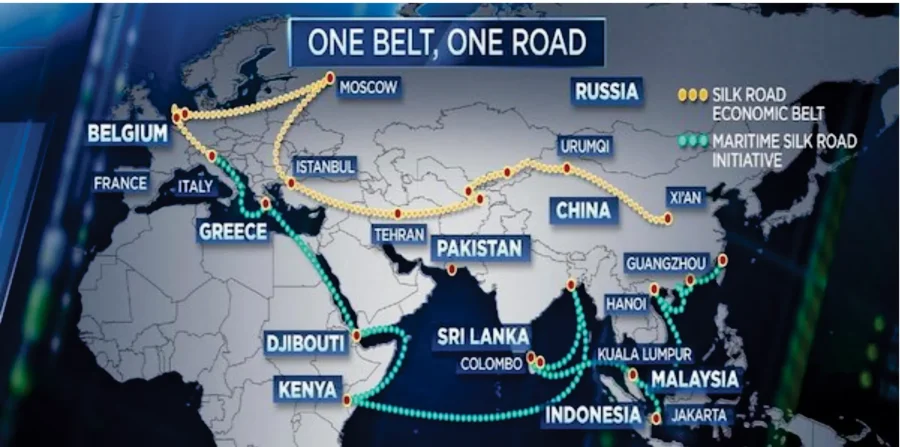BRI stands for greater regional connectivity
Most recently Uzbekistan’s President Shavkat Mirziyoyev attended the China-Central Asia Summit in Xi’an city and delivered a “keynote” speech during which he upheld that Central Asian countries and China have developed a “mature” relationship based on trust, respect and “mutual interest”.
During his speech Mirziyoyev rightly proposed the “goals” of further increasing the trade volume between Central Asian countries and China by 2030 through promoting “balanced growth” in the supply of industrial goods and agricultural products, establishing effective trade and logistics infrastructure and modern wholesale distribution networks as well as establishing “green channels” and unified e-commerce platforms. Thus he endorsed the “strategic importance” and utility of the BRI.
In 2015, Uzbekistan became a partner of the BRI and joined the Asian International Investment Bank (AIIB). Both countries signed over 100 bilateral agreements which have further strengthened their economic cooperation. China-Uzbekistan bilateral trade has increased “140 times” in the last 30 years. It increased by 21.8 percent to nearly “US$9.78 billion” in 2022-2023 which is getting momentum by each passing day. Uzbekistan also showed strong interest in cooperating with China on electric vehicles, new energy industry and digital cooperation. Moreover, Qamchiq Tunnel in Uzbekistan has revolutionized the concept of regional connectivity.
Interestingly, in the first meeting of the heads of C+C5 countries, China emphasized Uzbekistan to deepen industrial cooperation, investment and win-win cooperation in BRI and to increase regional industrial development in sectors such as digital economy, energy and agriculture.
China’s interaction with Uzbekistan is to further develop “South-South Cooperation” through BRI and the construction of an alternative route which would further strengthen existing maritime routes, regional hydrocarbon and mineral resources, export markets, loans and investments in the local economy.
Interestingly, Uzbekistan holds “strategic importance” in the further development of BRI because in the China-Central Asia-West Asia BRI Corridor, two of the BRI routes pass through Uzbekistan, which will connect it to China and Iran. It also ideally positions in Kazakhstan, Uzbekistan, (Tashkent, Samarkand, Navi), and Turkmenistan Corridor, while it also keeps its key position in Kyrgyzstan, Uzbekistan (Andijan, Pap, Tashkent, Samarkand, Navi) and Turkmenistan-Iran Corridor.
China’s BRI has invested in Uzbekistan in sectors such as industries, raw material, energy, infrastructure, telecommunications, advanced technology, construction of thermal power plants and upgrading of hydroelectric power plants, development of digital and fiber optic infrastructure, and 5G.
Chinese companies under the BRI are also active in the sectors such as renewable energy resources and mining of Uzbekistan, especially in the cement sector and numerous factory projects, special economic zones, free trade zones, industrial parks (SEZs), building material, chemical and chemical industry companies, agriculture and logistics and textiles. Cooperation between the BRI and the development strategy of New Uzbekistan for 2022-2026 has also been taken on by Beijing.
More attention has been paid to the “China-Kyrgyzstan-Uzbekistan road corridor” and the “China-Kyrgyzstan-Uzbekistan railway”. In mid-September 2022, the representatives of these three countries signed a memorandum of cooperation for the implementation of the China-Kyrgyzstan-Uzbekistan railway or CKU project.
Uzbekistan is the “largest consumer market” in Central Asia and a major regional “agricultural” and “manufacturing” exporter. Uzbekistan-BRI can be an ideal “geographical axis” of connecting China, South Eurasia, South Asia and the Middle East, the Caspian Sea, Persian Gulf ports and the Black Sea. The completion of the BRI projects will greatly increase the trade, investment, and GDP of Uzbekistan and the competitiveness of Uzbekistan’s exports.
China plans to increase trade with the five Central Asian countries to US$70 billion by 2030. Uzbekistan’s future potential for continued BRI inclusion is significant with Uzbekistan signing BRI infrastructure related contracts worth US$16 billion with China in 2022. By using the BRI, Uzbekistan is diversifying its infrastructure network and reducing delivery times to the country by approximately 15 percent.
It is good omen that the Uzbek government termed BRI as an important contribution to reaching the national GDP goal of US$100 billion in GDP, doubling exports to more than US$30 billion dollars by 2030, and diversifying the economy.
To conclude, Uzbekistan’s President Shavkat Mirziyoyev presented comprehensive “roadmap” of greater regional connectivity and pinpointed that the widening gaps in sustainable transport and logistics chains, food and energy security challenges, emerging socio-economic and geopolitical instability out of constant tight monetary policy, economic meltdown and high inflation causing serious risks for all the Central Asian countries which should be handled closer coordination and practical interaction. Thus he rightly supported the basic concept of the China-Central Asia Summit and the BRI i.e. greater regional connectivity and immense socio-economic integration.
The Uzbek President highlighted the importance of establishing the effective interaction mechanisms in the main areas of regional cooperation mainly trade, investment, transport and humanitarian ties and fully supported the further development of BRI.
He emphasized the strategic importance of achieving and securing sustainable development for improving the living standards of the population and the efficiency of poverty reduction. He suggested initiating a new economic dialogue and strengthening the interconnectedness for achieving the Global Goals and 2030 Agenda for Sustainable Development.
Furthermore, deepening industrial cooperation, attracting digital technologies and introducing innovations, especially in agriculture, can be effectively resolved through direct interregional contacts with the provinces of China, he further added.
He rightly showcased that the revival of the “Great Silk Road and the Trans-Eurasian Highway would be key components of the China-Kyrgyzstan-Uzbekistan automobile and railroad.
In this connection, the construction of the Trans-Afghan Corridor will further enhance connectivity with China, especially Pakistan, and the countries of South Asia by alternative ways within the BRI mechanism.
It seems that Uzbekistan’s President Shavkat Mirziyoyev “Development Strategy 2022-2026” coincides with the Chinese President’s GDI, GSI and GCI consolidating the spirit of community with a shared future. The dream of CPEC greater regional connectivity directly relates to the further strengthening of China-Central Asia and BRI. The Trans-Regional Rail project of Uzbekistan-Pakistan and Afghanistan would further strengthen the true spirit of greater regional connectivity in the days to come.








